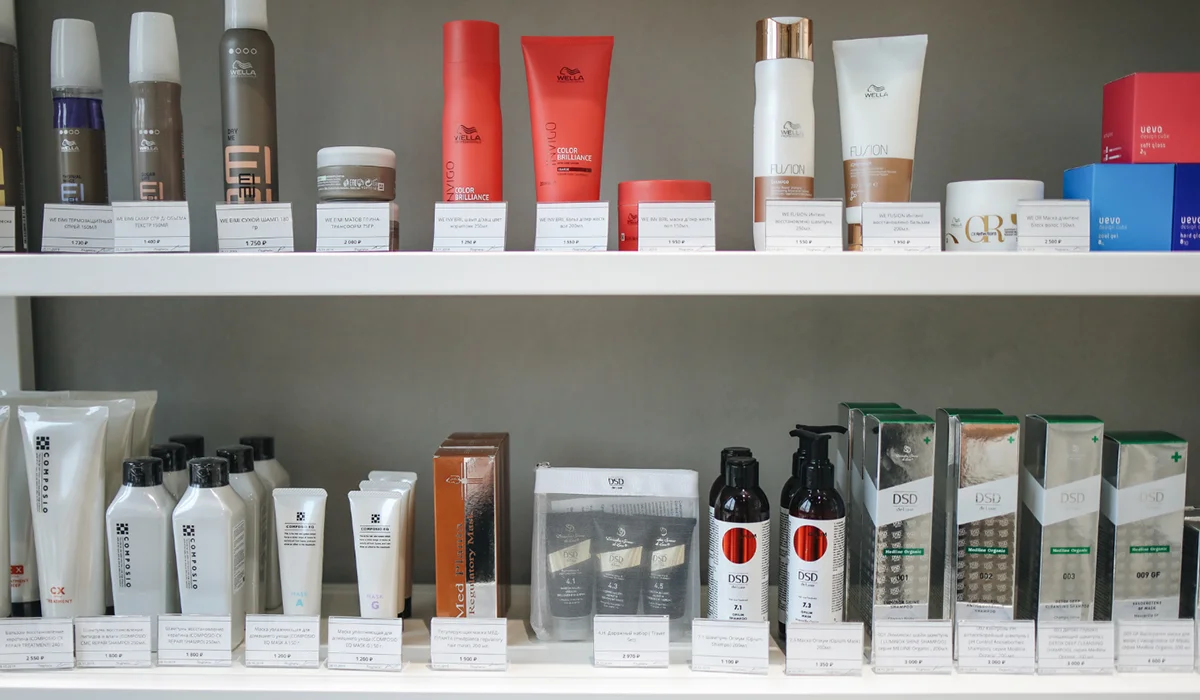Harmful ingredients hide in most everyday beauty products we use. Since 2009, 595 cosmetics manufacturers have reported using 88 chemicals linked to cancer, birth defects, or reproductive harm in more than 73,000 products. This serious problem affects almost everyone.
American women’s daily routine involves 12 personal care products containing 168 different chemicals, while men use about six products with 85 different chemicals. Many toxic ingredients in skincare can disrupt our hormones and block estrogen production. Parabens, which manufacturers have used as preservatives since the 1920s, show up in nearly all urine samples from U.S. adults, whatever their demographics. The CDC’s findings reveal propylparaben in over 92 percent of tested Americans. These skincare ingredients don’t just pass through our bodies harmlessly – our skin, the body’s largest organ, absorbs them directly.
This piece examines skincare’s harmful ingredients that block estrogen, their effects on your hormones, and ways to protect yourself from these dangerous substances. California Assembly Bill 2762, the Toxic-Free Cosmetics Act, proposes banning many of these toxic ingredients from cosmetics. Until then, we must become our own safety advocates when choosing beauty products.
How harmful ingredients in beauty products affect your hormones
The beauty industry has a dark secret—personal care products contain endocrine-disrupting chemicals (EDCs) that change how our bodies work. These substances don’t just stay on your skin. They make their way into your bloodstream and mess with the delicate hormone balance that controls many body functions.
How estrogen blockers interfere with the endocrine system
Endocrine disruptors are natural or human-made chemicals that mimic, block, or interfere with your body’s hormones—the messengers of our endocrine system. These harmful ingredients pose a real threat because hormones work in tiny amounts, and even small changes in their levels can lead to major developmental and biological effects.
The process seems simple but creates havoc in your body. Some toxic ingredients in skincare products directly copy hormones like estrogen. The chemical fools the hormone’s receptor into thinking it’s the real hormone. Other ingredients stop hormones from working by attaching to receptors without turning them on, which blocks natural hormones from doing their job.
Parabens in cosmetics and body creams show this clearly. These chemicals penetrate your skin and act like weak estrogen—potentially causing hormone-receptor-positive breast cancers to grow. The same goes for phthalates, which throw off hormone balance by messing with hormones that work with estrogen, including testosterone.
On top of that, chemicals like oxybenzone in sunscreens can seep through your skin into the bloodstream and act as suspected endocrine disruptors. Scientists have found these harmful ingredients in household dust, blood, and urine samples worldwide.
Why hormone disruption is a serious health concern
Hormone disruption creates problems that go way beyond minor health issues. Your endocrine system controls vital functions like reproduction, metabolism, growth, and development. Toxic ingredients that mess with these processes can trigger serious health problems:
- Reproductive disorders: Research shows that exposure to certain levels of cosmetic chemicals may lead to fertility problems and issues with reproductive system development.
- Cancer risk: Estrogen can fuel hormone-receptor-positive breast cancer growth, which leads many women to avoid these chemicals. Research links EDC exposure to higher risks of breast and uterine cancer.
- Developmental issues: Children and pregnant women face the biggest risks. EDCs are most dangerous during prenatal and early postnatal development as organs and neural systems form. Exposure during pregnancy links to unusual growth patterns and early puberty.
- Metabolic and cognitive disorders: EDCs have connections to metabolic disorders, including diabetes and obesity, plus cognitive problems. Research shows that exposure to certain phthalates relates to ADHD-like behaviors in teens.
These effects can happen even with small amounts of exposure. Science shows that even low levels of endocrine-disrupting chemicals might harm you. One researcher puts it clearly: “The body’s normal endocrine functioning involves very small changes in hormone levels, yet we know even these small changes can cause significant developmental and biological effects”.
The hidden dangers in personal care products aren’t just about avoiding bad skincare ingredients—they’re about protecting your health for years to come.
Top 5 common ingredients acting as estrogen blockers
Beauty products you apply daily might expose you to hidden chemicals that disrupt your body’s delicate hormonal balance. Let’s get into five of the most important harmful ingredients that block estrogen. These deserve your attention right now.
1. Parabens (methyl-, propyl-, butyl-, isobutyl-)
Parabens serve as synthetic preservatives that have been accessible to more people since the 1950s. They prevent bacterial growth in cosmetics, foods, and medicines. Scientists have found these chemicals—listed as methylparaben, propylparaben, butylparaben, or isobutylparaben—in all but one of these urine samples from U.S. adults. They copy estrogen by binding to estrogen receptors and can trigger hormone-sensitive cancers. The FDA says parabens are safe in small amounts. However, independent studies show they relate to altered endocrine activity, carcinogenesis, infertility, obesity, and hypersensitivity. Long-term exposure to paraben mixtures can cause local changes that contribute to breast carcinogenesis.
2. Phthalates (DBP, DEHP)
Plastic additives called phthalates make products flexible and durable. Diethylhexyl phthalate (DEHP) and dibutyl phthalate (DBP) raise the most concerns. Your body absorbs these chemicals through food, air, and skin—they build up in blood, amniotic fluid, and urine. These powerful endocrine disruptors relate to infertility in both men and women. DEHP specifically shows strong connections to insulin resistance, higher systolic blood pressure, and reproductive issues. These include earlier menopause, low birth weight, pregnancy loss, and preterm birth. Children face higher risks—82-89% of children had DBP exposure above reproductive health standards.
3. Triclosan
Triclosan started as a pesticide in the 1960s and now serves as an antibacterial agent in products from toothpaste to deodorants. The FDA banned triclosan from consumer antibacterial soaps in 2016. Manufacturers couldn’t prove it was safe or worked. Many personal care products still contain triclosan. This endocrine-disrupting chemical can damage your endocrine system and affect proper hormone function. Research reveals triclosan can impact thyroid, ovarian, and testis homeostasis. It can increase estrogen and progesterone secretion through estrogen receptor signaling pathways. This might promote hormone-dependent cancers like breast and ovarian cancer.
4. Oxybenzone (in sunscreens)
Oxybenzone, a common UV filter in sunscreens, passes through skin into your bloodstream. CDC research shows that people’s oxybenzone levels relate directly to their sunscreen use. Studies prove this chemical mimics estrogen, interferes with testosterone production, and disrupts adrenal hormones. The largest longitudinal study in 2023 covering 254 studies found growing evidence about oxybenzone’s endocrine-disrupting properties at typical sunscreen use doses. Reproductive problems emerged as the main concern. The European Commission reported in 2021 that current human exposure levels weren’t safe. They proposed limiting its concentration to 2.2 percent in body lotion and spray sunscreen—60 percent lower than U.S. standards of 6 percent.
5. PFAS (per- and polyfluoroalkyl substances)
“Forever chemicals” or PFAS resist breakdown in our environment and bodies. Some compounds take decades to degrade. These man-made chemicals show up in cosmetics like foundations, moisturizers, and anti-aging products. They create a shiny look and smoother feel. Research indicates PFAS exposure relates to altered female reproductive function, including irregular periods and changed hormone levels. Some PFAS compounds mimic estrogen and overstimulate estrogen receptors. This overstimulation starts transcription and gene expression that shouldn’t happen. It disrupts growth and sex hormone function. PFAS ended up causing several health issues, including liver toxicity, altered immunity, kidney disease, and cancer.
How these toxic ingredients enter your body
Beauty products can expose you to toxic ingredients through multiple pathways in your body. Smart choices about products and their usage start with understanding these exposure routes.
Absorption through skin and scalp
Your skin, the body’s largest organ, doesn’t block everything. Harmful ingredients in beauty products can easily enter your bloodstream through your skin and mucous membranes. This happens continuously because these products stay in contact with your skin.
Research confirms that metals in beauty products enter the bloodstream through skin absorption and can cause harmful effects. The problem runs deep – scientists have found endocrine-disrupting chemicals from everyday cosmetics in blood, urine, breast milk, and amniotic fluid.
Teenagers and pregnant women face greater risks. Teen girls use about 17 personal care products daily, while adult women use 12. This means teens might expose themselves to more harmful ingredients during crucial developmental stages.
Inhalation from sprays and powders
Spray products and loose powders create tiny airborne particles you breathe straight into your lungs. Face powders release large amounts of these particles. Studies show PM10 levels can reach 222.4 µg/m³ and PM2.5 levels up to 67.9 µg/m³.
Particle size determines how deep these substances travel in your respiratory system. Particles bigger than 10 µm can’t reach the pulmonary region. Smaller particles penetrate deeper into your lungs.
Studies reveal that cosmetic spray particles stay in your breathing space for up to 10 minutes after use. About 35% of these particles fall away within a minute, but the rest hang around – ready to enter your lungs with each breath.
Ingestion from lip products
Lip products offer a direct path into your body. You eat these products throughout the day, unlike other cosmetics. Women might consume a pound of lipstick every two years.
Scientists have found dangerous levels of metals like lead, aluminum, cadmium, and manganese in lip products. Research shows 75% of tested lip products contained lead, with 15 samples having more lead than the FDA allows in candy.
Studies of lip products used by young women revealed alarming results. Regular users (24 mg/day) consume aluminum, cadmium, chromium, and manganese at levels above 20% of safe daily limits. Heavy users (87 mg/day) face even greater exposure – 68% of products exceeded safe chromium intake levels.
Why these ingredients are still allowed in the U.S.
Beauty product regulations in the United States reveal a harsh truth for consumers worried about harmful ingredients. These toxic ingredients stay mostly uncontrolled because of old laws and major gaps in regulation, despite growing proof of health risks.
Lack of FDA authority over cosmetics
The FDA’s power over cosmetics comes from the 80-year-old Food, Drug, and Cosmetic Act. This outdated law doesn’t let the FDA demand pre-market approval for cosmetic products or ingredients, except color additives. The EPA has banned only six chemicals out of more than 40,000 on the U.S. market. The FDA can’t require safety testing, ask companies to share safety data, or order recalls of dangerous products. Manufacturers don’t need to prove their products are safe – the FDA must prove they’re harmful. This weak oversight continues because manufacturers won a federal court battle when the EPA tried stronger chemical controls in 1989.
Fragrance loophole and hidden chemicals
The “fragrance loophole” stands as the most concerning issue. Companies can hide dozens or hundreds of unnamed chemicals under one word: “fragrance” on product labels. U.S. regulations protect these fragrance formulas as “trade secrets”. This means ingredients like phthalates can exist in products without being listed. A newer study showed that more than half of tested cosmetics had dangerous levels of PFAS chemicals, yet only 8% listed them as ingredients. More than 3,600 chemicals go into fragrance mixtures worldwide, leaving many consumers unaware of what they apply to their skin.
Comparison with EU and international bans
The European Union takes a safer approach than America’s regulatory system. The EU prohibits more than 1,300 cosmetic ingredients, while the FDA has banned just 11. To name just one example, see 4-Methylbenzylidene camphor, a UV filter in sunscreens – the EU, Japan, and USA banned it due to endocrine disruption evidence, but the UK still allows it. The EU also blocks EDCs from pesticides through detailed rules created in 2009 and 2012. Products made for European markets look quite different from their American versions because of these tighter safety rules.
How to protect yourself from estrogen-blocking chemicals
Your beauty routine needs constant alertness and knowledge. The right tools and awareness can help you reduce exposure to harmful ingredients that affect your hormonal health by a lot.
Read ingredient labels carefully
Product labels should be your first defense. Cosmetic labels list ingredients by concentration, with the highest percentages appearing first. The first few ingredients make up most of what you put on your skin. Products that claim to be hypoallergenic or non-comedogenic use unregulated terms that don’t guarantee safety from hormone-disrupting chemicals.
Use apps like EWG Skin Deep or Think Dirty
Technology makes it easier to spot toxic ingredients. EWG’s Skin Deep database rates the safety of over 78,000 cosmetics and personal care products from more than 2,500 brands. This useful tool combines ingredient lists with data from over 60 toxicity and regulatory databases. Think Dirty lets you scan product barcodes and rates items from 0 to 10. Higher numbers show greater potential concerns. Both apps suggest clean product alternatives to help you make healthier choices.
Choose products labeled ‘paraben-free’ or ‘phthalate-free’
Manufacturers now highlight formulations without known endocrine disruptors. Labels marked “paraben-free,” “phthalate-free,” or “fragrance-free” catch your eye quickly. Fragrances often hide phthalates inside them. These products usually contain fewer toxic ingredients and mark a step toward safer beauty choices.
Look for third-party certifications like EU Ecolabel
EU Ecolabel certification gives you extra confidence about product safety. Products with this mark must limit hazardous substances, avoid allergenic fragrances or lotions, and create less waste. The certification bans many concerning ingredients such as parabens, phthalates, PFAS (per- and polyfluorinated substances), triclosan, and benzophenones. These are the same estrogen blockers we discussed earlier. COSMOS, ECOCERT, and NATRUE offer other reliable certifications.
Conclusion
Beauty products contain toxic ingredients that pose serious health risks we can’t ignore anymore. Common chemicals like parabens, phthalates, triclosan, oxybenzone, and PFAS block estrogen and disrupt our hormonal balance. These chemicals could lead to reproductive disorders, cancer, and developmental problems. Our bodies absorb these harmful substances through our skin. We also inhale and ingest them without knowing.
The United States faces a major regulatory problem compared to European Union countries. The 1938 Food, Drug, and Cosmetic Act lets cosmetic companies regulate themselves. The “fragrance loophole” allows manufacturers to hide dozens of chemicals under one simple term.
We can protect ourselves by learning about these hidden dangers. Reading ingredient labels helps a lot. Using reliable apps like EWG Skin Deep or Think Dirty makes a difference. Products with “paraben-free” or “phthalate-free” labels reduce our exposure to hormone-disrupting chemicals. Third-party certifications like EU Ecolabel offer extra protection and ensure products meet strict safety standards.
Beautiful skin shouldn’t compromise our hormonal health. Smart choices about beauty products protect us and future generations from these endocrine disruptors. The beauty industry just needs complete reform. Until then, our awareness and buying decisions can create demand for safer options.
Take a moment before buying your next beauty product. Check what’s in it. Get a safety app. Look for real certifications. Your hormones will thank you.




